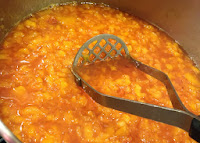Chef Kathryn LaSusa Yeomans of The Farmer's Feast and farmer Roger Konka kick off another season of their field-to-pop-up dinners, raved by none other than GQ food critic Alan Richman as "a glorification of farm, field, woods and wild" in a review of one of their events last year. This dinner, titled "Sunday Supper Revival," focuses on fall, with wild mushrooms, corn, pork and huckleberries all picked, foraged or raised by Konka and his family at Springwater Farm, with a scattering of other ingredients from local producers. They've also landed a new location, at Tabor Bread on SE Hawthorne, and the dinner will feature its breads, as well. Incredibly affordable, incredibly delicious…what more could you ask?
Details: The Farmer's Feast Sunday Supper Revival. Sun., Oct. 6, 6 pm; $35 per person, excluding beverages & gratuity. Local wine & beer will be offered. Reservations required via e-mail or phone at
503-734-4329. Event at Tabor Bread, 5051 SE Hawthorne Blvd.
* * *
Fall is festival time in the Northwest, celebrating all things artisan from local beers to charcuterie and all manner of handmade foodstuffs. One of the biggies the last few years has been The Wedge, Portland's paen to our rich dairy culture (pun intended) that benefits the Oregon Cheese Guild, which helps promote and support our exceptional cheesemakers. This year's festival features no fewer than 30 specialty and artisan cheesemakers, craft breweries and food producers from across the Northwest who are coming together to celebrate cheese. Sample, sip and support these local artisans!
Details: The Wedge, Portland's Celebration of Local Cheese. Sat., Oct. 5, Noon-5 pm; $5 donation suggested. Event at the Green Dragon Bistro and Brew Pub and environs, 928 SE 9th St. 503-616-4443.
* * *
Good event spaces in Northeast Portland are hard to come by. The ones that are available can be too small or too cavernous or a little down-at-the-heels. Which is why I was pleased to come across the Red Rose Ballroom, a 4,600 square foot ballroom built in 1925 that has been renovated and reopened as a creative events space in the last couple of weeks. It's big enough for large events, but doesn't feel too big for smaller events, and the wood floor had me feeling like waltzing. Check it out!
Details: Red Rose Ballroom, 1829 NE Alberta St. 415-285-1285.
Top photo by Kathryn LaSusa Yeomans. Cheese photo by Tami Parr of Pacific NW Cheese.











































